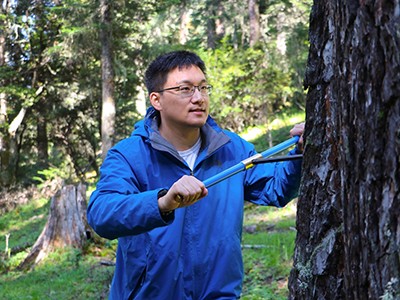DNA samples from one of the world’s largest and oldest plants — a quaking aspen tree (Populus tremuloides) in Utah called Pando — have helped researchers to determine its age and revealed clues about its evolutionary history.
By sequencing hundreds of samples from the tree, researchers confirmed that Pando is between 16,000 and 80,000 years old, verifying previous suggestions that it is among the oldest organisms on Earth. They were also able to track patterns of genetic variation spread throughout the tree that offer clues about how it has adapted and evolved over the course of its lifetime. The findings were posted on the bioRxiv preprint server on 24 October1. The work has not yet been peer reviewed.
“It’s just pretty cool to study such an iconic organism,” says co-author Rozenn Pineau, a plant evolutionary geneticist at the University of Chicago in Illinois. “I think it’s important to draw people’s attention on natural wonders of the world.”
One very big tree
Pando — whose name means ‘I spread’ in Latin — consists of some 47,000 stems that cover an area of 42.6 hectares in Utah’s Fishlake National Forest. Because of the way the plant reproduces, this collection of aspens is technically all one tree, supported by a single, vast root system. Pando is triploid, meaning that its cells contain three copies of each chromosome, rather than two. As a result, Pando cannot reproduce sexually and mix its DNA with that of other trees, and instead creates clones of itself.
The trees’ lessons: climate records are written in tree rings
Although this process generates offspring that are genetically identical, they can still accumulate genetic mutations as their cells divide. Biologists are interested in these variations because they provide information on how the plant has changed since the first seedling sprouted. Some studies have explored the spread of new mutations in plants and fungi that reproduce clonally, but few have investigated centuries-old plants like Pando.
“It’s kind of shocking to me that there hasn’t been a lot of genetic interest in Pando already, given how cool it is,” says study co-author William Ratcliff, an evolutionary biologist at the Georgia Institute of Technology in Atlanta.
The researchers collected samples of roots, bark, leaves and branches from across the Pando clone, as well as from other, unrelated quaking aspen trees for comparison. They extracted DNA from the samples, then sequenced and analysed a subsection of the genome.
After removing variants that were found in both Pando and neighbouring trees, as well as mutations found in just one sample, the researchers were able to review nearly 4,000 genetic variants that had arisen as Pando cloned itself repeatedly over millennia.
Analysing the patterns of these mutations revealed surprising results. “You would expect that the trees that are spatially close are also closer genetically,” says Pineau. “But this is not exactly what we find. We found a spatial signal, but that is much weaker than what we expected.” Physically close trees did share more similar mutations than those that were far apart — but only slightly more. However, over a smaller scale of 1–15 metres the trend was stronger, with stems that were closer together having significantly more shared mutations. Pando covers an area of more than 40 hectares, “but it almost looks like it’s a well-mixed pot of genetic information”, says Ratcliff.
Protective mechanism
By inputting Pando’s genetic data into a theoretical model that plots an organism’s evolutionary lineage, the researchers also estimated Pando’s age. They put this at between 16,000 and 80,000 years. “It makes the Roman Empire seem like just a young, recent thing,” says Ratcliff.
The team also considered reasons for the tree’s remarkable endurance. Pineau says that Pando being triploid might lead to “bigger cells, bigger organisms, better fitness”, and that existing clones might be more durable than new mixed offspring.
Philippe Reymond, who researches interactions between plants and herbivores at the University of Lausanne in Switzerland, says that the findings hint that “plants and trees have a mechanism to protect the genome” from the accumulation of harmful genetic mutations, a suggestion that is “quite interesting for many scientists”. He adds that future studies could search for this exact mechanism at the cellular level.
Ratcliff is also keen for more studies to be done on Pando’s genetic history. “I would love to make a call for people to work on these kinds of organisms,” he says.



